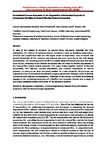Consolidation process boundaries of the degradation of mechanical properties in compression moulding of natural-fibre bio-polymer composites
| dc.contributor.author | Khanlou, HM | |
| dc.contributor.author | Woodfield, P | |
| dc.contributor.author | Summerscales, John | |
| dc.contributor.author | Hall, W | |
| dc.date.accessioned | 2017-03-30T08:39:45Z | |
| dc.date.available | 2017-03-30T08:39:45Z | |
| dc.date.issued | 2017-04-01 | |
| dc.identifier.issn | 0141-3910 | |
| dc.identifier.issn | 0141-3910 | |
| dc.identifier.uri | http://hdl.handle.net/10026.1/8741 | |
| dc.description.abstract |
In spite of the volume of literature on natural fibres, bio-matrix materials and their composites, the choices of optimum process parameters such as moulding temperature, pressure and compression time are still largely based on experience, rules of thumb and general knowledge of the chemical and physical processes occurring in the melt during consolidation. The moulding process itself is a complex balance between processes that must occur for the composite to successfully consolidate and the onset of thermal degradation of the natural fibre and/or matrix materials. This paper brings together models of thermal penetration, melt infusion, thermal degradation and chemical degradation of natural polymers to construct an ideal processing window for a bio-composite. All processes are mapped in terms of normalized consolidation progress parameters making it easier to identify critical processes and process boundaries. Validation of the concept is achieved by measuring changes in the mechanical properties of a flax/PLA bio-composite formed over a range of processing conditions within and outside of the optimized window. | |
| dc.format.extent | 115-125 | |
| dc.language | en | |
| dc.language.iso | en | |
| dc.publisher | Elsevier | |
| dc.subject | Bio-polymer composites | |
| dc.subject | Chemical degradation | |
| dc.subject | Natural fibres | |
| dc.subject | Mechanical properties | |
| dc.subject | Thermal processing degradation | |
| dc.title | Consolidation process boundaries of the degradation of mechanical properties in compression moulding of natural-fibre bio-polymer composites | |
| dc.type | journal-article | |
| dc.type | Journal Article | |
| plymouth.author-url | https://www.webofscience.com/api/gateway?GWVersion=2&SrcApp=PARTNER_APP&SrcAuth=LinksAMR&KeyUT=WOS:000400222500013&DestLinkType=FullRecord&DestApp=ALL_WOS&UsrCustomerID=11bb513d99f797142bcfeffcc58ea008 | |
| plymouth.volume | 138 | |
| plymouth.publication-status | Published online | |
| plymouth.journal | Polymer Degradation and Stability | |
| dc.identifier.doi | 10.1016/j.polymdegradstab.2017.03.004 | |
| plymouth.organisational-group | /Plymouth | |
| plymouth.organisational-group | /Plymouth/Faculty of Science and Engineering | |
| plymouth.organisational-group | /Plymouth/Faculty of Science and Engineering/School of Engineering, Computing and Mathematics | |
| plymouth.organisational-group | /Plymouth/REF 2021 Researchers by UoA | |
| plymouth.organisational-group | /Plymouth/REF 2021 Researchers by UoA/UoA12 Engineering | |
| plymouth.organisational-group | /Plymouth/Research Groups | |
| plymouth.organisational-group | /Plymouth/Research Groups/Marine Institute | |
| plymouth.organisational-group | /Plymouth/Users by role | |
| plymouth.organisational-group | /Plymouth/Users by role/Academics | |
| dcterms.dateAccepted | 2017-03-06 | |
| dc.rights.embargodate | 2018-3-7 | |
| dc.identifier.eissn | 0141-3910 | |
| dc.rights.embargoperiod | 24 months | |
| rioxxterms.versionofrecord | 10.1016/j.polymdegradstab.2017.03.004 | |
| rioxxterms.licenseref.uri | http://www.rioxx.net/licenses/under-embargo-all-rights-reserved | |
| rioxxterms.licenseref.startdate | 2017-04-01 | |
| rioxxterms.type | Journal Article/Review |


